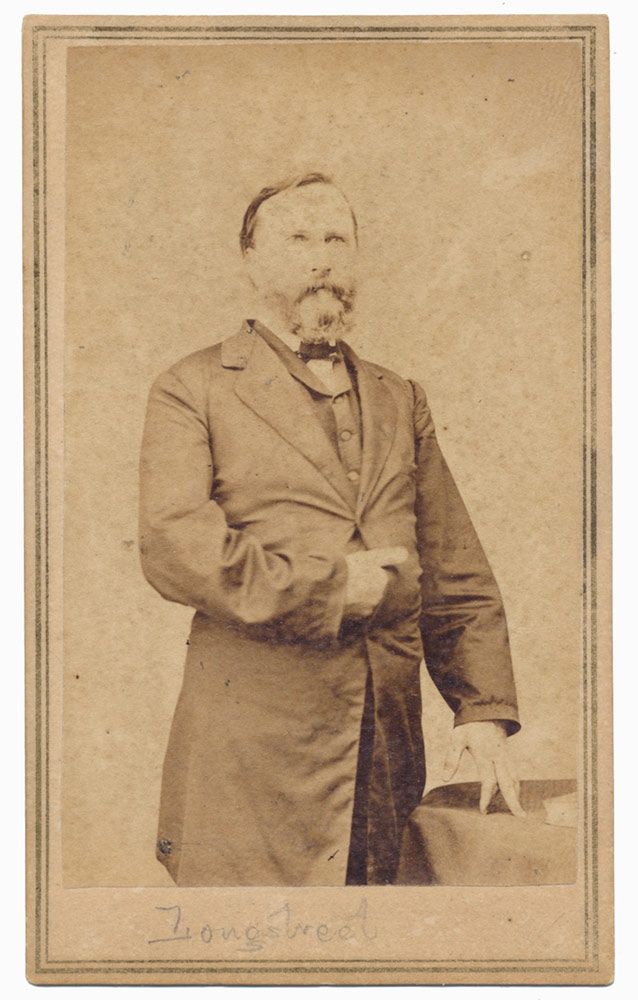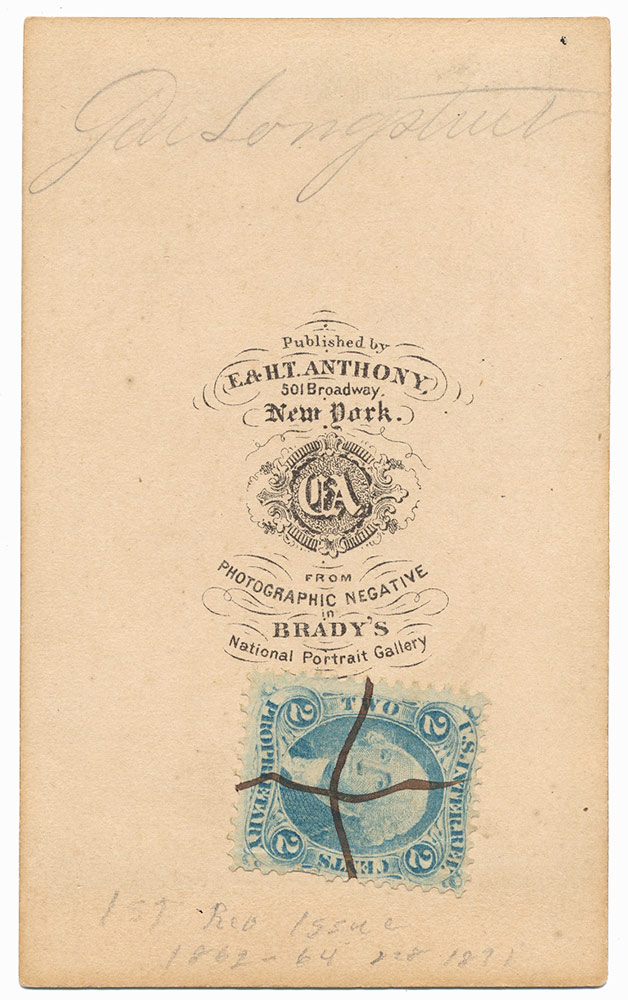site search
online catalog
EARLY POST-WAR VIEW OF GENERAL LONGSTREET IN A CIVILIAN SUIT BY ANTHONY

Hover to zoom


$200.00 SOLD
Quantity Available: None
Item Code: 2022-396
CDV is a three quarter standing view of James Longstreet in a dark civilian suit. He is posed with one hand thrust in his coat and the other resting on a table next to a book.
Contrast and clarity are good. Mount and paper are also good but with minor scattered surface dirt from age. Bottom center of mount has a faint pencil ID of “LONGSTREET.”
Reverse has a photographer’s imprint for E. & H. T. ANTHONY FROM A BRADY NEGATIVE. Top of reverse has a faint period pencil ID of “GEN. LONGSTREET” with a canceled 2 cent tax stamp which dates the image between August of 1864 and August of 1866.
James Longstreet was born January 8, 1821 in South Carolina, but spent much of his childhood at the home of his uncle, Augustus Baldwin Longstreet in Augusta, Georgia. Longstreet went on to attend West Point, where he graduated fifty-fourth out of sixty-two cadets in the class of 1842.
Longstreet’s first real war experience came during the Mexican War. From 1846 to 1848 he rendered distinguished service at Vera Cruz, Churubusco, and Chapultapec, where he was wounded. Recognized for his bravery, Longstreet would continue his army career, participating in the Indian Wars and rising to the rank of major by 1858.
At the outbreak of the Civil War, Longstreet, then serving in New Mexico Territory, resigned his commission after nearly twenty years of service. He was very quickly appointed Brigadier General under P.G.T. Beauregard and reported for duty in July of 1861. Following his first action at Blackburn's Ford, Longstreet received praise for his coolness under fire and the manner in which he inspired his men. Longstreet and Thomas “Stonewall” Jackson were both promoted to Major General under Joseph E. Johnston in October 1861. Following his promotion Longstreet commanded a division of six brigades–the nucleus of what would eventually become the First Corps of the Army of Northern Virginia.
Longstreet performed admirably during the Peninsula Campaign despite receiving news of the death by disease of his three children. That August, at Second Manassas, Longstreet’s wing of 28,000 men counterattacked the Union forces in what has been called “the largest, simultaneous mass assault of the war. The Union left flank was crushed and the army driven back to Bull Run.” Longstreet was also noticed for his excellent performance the following month at Antietam, and his extraordinary coolness under fire continued to be a trademark.
When Jackson's Corps was assimilated into the Army of Northern Virginia, Longstreet was promoted to Lieutenant General and his corps was officially designated as the First Corps. During the incredibly bloody battle of Fredericksburg that December, Longstreet created an almost impenetrable defense along Marye’s Heights. From February to April 1863, Longstreet led two of his divisions to Southeast Virginia for the collecting of food and forage, and was therefore not present at the battle of Chancellorsville that May.
Longstreet did, however, rejoin Lee's Army for the second invasion of the North and the subsequent battle of Gettysburg. During that battle Longstreet commanded the Confederate right and nearly broke the Union line on July 2nd. On July 3, in perhaps the war's most famous episode, troops from Longstreet's corps under Maj. General George Pickett charged across open fields to assault the Union center only to be repulsed, again at a great loss. For the remainder of his life, Longstreet would continually assert his opposition to Lee's command decisions at Gettysburg, much to the disdain of his fellow officers. This opposition, combined with allegations that he deliberately delayed the execution of Lee's orders, did much to tarnish Longstreet's reputation.
That autumn, Longstreet was sent west to the aid of the beleaguered Braxton Bragg. His troops arrived on September 20, just in time to rout a significant portion of the Union line at Chickamauga. The stubborn Gen. Bragg, however, was less than warm in his reception of Gen. Longstreet and his staff, especially when several of Longstreet's generals wished to have Bragg removed from command. President Davis would not remove Bragg, and Longstreet’s reputation was damaged. After a difficult winter–and an abortive attempt at independent command in East Tennessee–Longstreet and his men were happy to return to the Army of Northern Virginia in April 1864.
At the Battle of the Wilderness in May 1864, Longstreet and his men performed well, finding a hidden route from which they could attack Union forces, catching them in a deadly crossfire. On May 6th, in an incident very similar to Stonewall Jackson’s mortal wounding the year before, Longstreet was fired on by his own men. A minié bullet passed through Longstreet’s neck and shoulder, permanently paralyzing the general's right arm. Though he survived, he did not return to his corps until October, by which time the Confederate army was dead-locked in defending the besieged city of Petersburg. Longstreet was assigned to protect Richmond and the vital railroads that supplied the city.
On April 2, 1865, Union forces broke the Confederate line at Petersburg. When A. P. Hill was killed, Longstreet took command of his Third Corps. On April 9, 1865, however, Lee surrendered the Army of Northern Virginia to Ulysses S. Grant at Appomattox. Longstreet and Lee parted ways on April 12, 1865. Longstreet moved to New Orleans, and the two men never saw each other again.
Perhaps no Confederate officer is surrounded by more controversy than James Longstreet. Called “Old Pete” and “My Old War Horse” by Gen. Robert E. Lee, Longstreet was Lee’s trusted advisor and friend. But, after the war, Longstreet became the target of many “Lost Cause” attacks. His letters to the New Orleans Times, his support of the Republican Party, and his memoirs served to alienate many Southerners.
Longstreet published his 800-page memoirs, From Manassas to Appomattox, in December 1895. In September 1897 he married 34-year-old Helen Dortch; although his family was not pleased with the marriage, Helen defended Longstreet’s name until she died in 1962. James Longstreet died on January 2, 1904, just days short of his 83rd birthday. He was buried at Alta Vista Cemetery in Gainesville, GA. [ad] [ph:L]
~~~~~~~~~~~~~~~~~~~~~~~~~~~~~~~~~~~
THIS ITEM, AS WITH ALL OTHER ITEMS AVAILABLE ON OUR WEB SITE,
MAY BE PURCHASED THROUGH OUR LAYAWAY PROGRAM.
CLICK HERE FOR OUR POLICIES AND TERMS.
THANK YOU!
Inquire About EARLY POST-WAR VIEW OF GENERAL LONGSTREET IN A CIVILIAN SUIT BY ANTHONY
Most Popular
Historical Firearms Stolen From The National Civil War Museum In Harrisburg, Pa »
Theft From Gravesite Of Gen. John Reynolds »
Selection Of Unframed Prints By Don Troiani »
Fine Condition Brass Infantry Bugle Insignia »
Large English Bowie Knife With Sheath 1870’S – 1880’S »
Imported (Clauberg) Us Model 1860 Light Cavalry Officer's Saber »
featured item
WONDERFUL CONDITION ORIGINAL CONFEDERATE-MANUFACTURED KEPI FOR A DRUMMER BOY OR CHILD
This article of uniform clothing is an original, Civil War example of headgear manufactured in the Confederacy and presented here in wonderful, original intact condition. The period artifact is a small, dark blue colored, wool kepi, suited for a… (526-68). Learn More »


